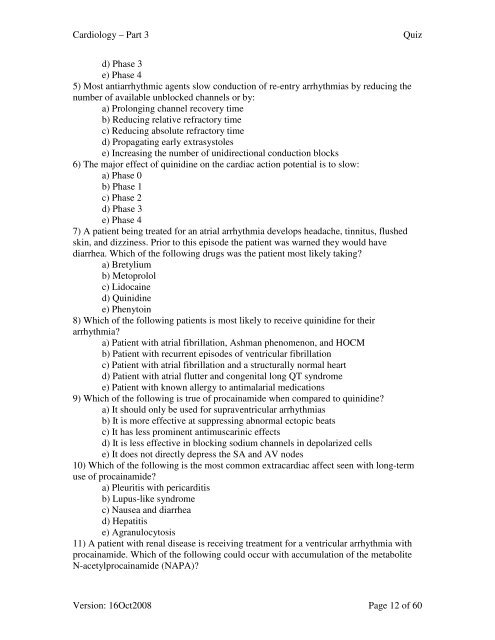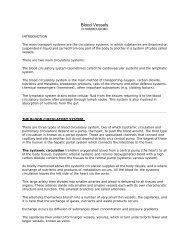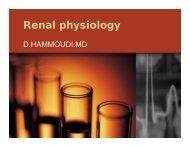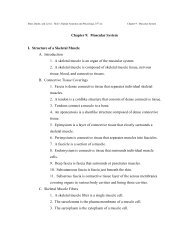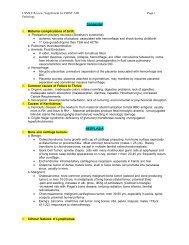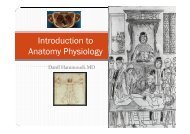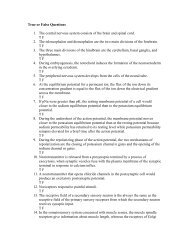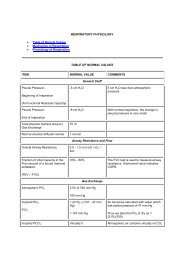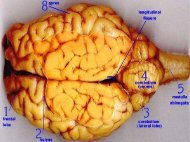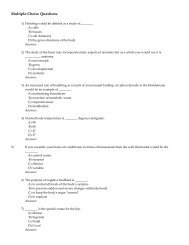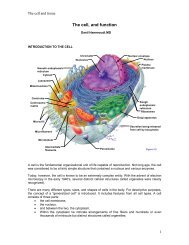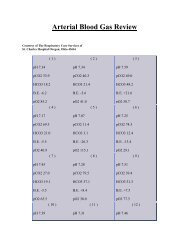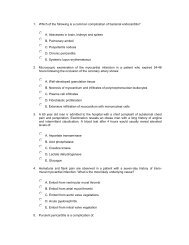Part 3 Quiz Version - Sinoe medical homepage.
Part 3 Quiz Version - Sinoe medical homepage.
Part 3 Quiz Version - Sinoe medical homepage.
You also want an ePaper? Increase the reach of your titles
YUMPU automatically turns print PDFs into web optimized ePapers that Google loves.
Cardiology – <strong>Part</strong> 3<br />
<strong>Quiz</strong><br />
d) Phase 3<br />
e) Phase 4<br />
5) Most antiarrhythmic agents slow conduction of re-entry arrhythmias by reducing the<br />
number of available unblocked channels or by:<br />
a) Prolonging channel recovery time<br />
b) Reducing relative refractory time<br />
c) Reducing absolute refractory time<br />
d) Propagating early extrasystoles<br />
e) Increasing the number of unidirectional conduction blocks<br />
6) The major effect of quinidine on the cardiac action potential is to slow:<br />
a) Phase 0<br />
b) Phase 1<br />
c) Phase 2<br />
d) Phase 3<br />
e) Phase 4<br />
7) A patient being treated for an atrial arrhythmia develops headache, tinnitus, flushed<br />
skin, and dizziness. Prior to this episode the patient was warned they would have<br />
diarrhea. Which of the following drugs was the patient most likely taking<br />
a) Bretylium<br />
b) Metoprolol<br />
c) Lidocaine<br />
d) Quinidine<br />
e) Phenytoin<br />
8) Which of the following patients is most likely to receive quinidine for their<br />
arrhythmia<br />
a) Patient with atrial fibrillation, Ashman phenomenon, and HOCM<br />
b) Patient with recurrent episodes of ventricular fibrillation<br />
c) Patient with atrial fibrillation and a structurally normal heart<br />
d) Patient with atrial flutter and congenital long QT syndrome<br />
e) Patient with known allergy to antimalarial medications<br />
9) Which of the following is true of procainamide when compared to quinidine<br />
a) It should only be used for supraventricular arrhythmias<br />
b) It is more effective at suppressing abnormal ectopic beats<br />
c) It has less prominent antimuscarinic effects<br />
d) It is less effective in blocking sodium channels in depolarized cells<br />
e) It does not directly depress the SA and AV nodes<br />
10) Which of the following is the most common extracardiac affect seen with long-term<br />
use of procainamide<br />
a) Pleuritis with pericarditis<br />
b) Lupus-like syndrome<br />
c) Nausea and diarrhea<br />
d) Hepatitis<br />
e) Agranulocytosis<br />
11) A patient with renal disease is receiving treatment for a ventricular arrhythmia with<br />
procainamide. Which of the following could occur with accumulation of the metabolite<br />
N-acetylprocainamide (NAPA)<br />
<strong>Version</strong>: 16Oct2008 Page 12 of 60


